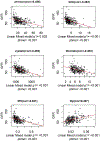Discovery and Validation of a Biomarker Model (PRESERVE) Predictive of Renal Outcomes After Liver Transplantation
- PMID: 31509263
- PMCID: PMC7883482
- DOI: 10.1002/hep.30939
Discovery and Validation of a Biomarker Model (PRESERVE) Predictive of Renal Outcomes After Liver Transplantation
Abstract
Background and aims: A high proportion of patients develop chronic kidney disease (CKD) after liver transplantation (LT). We aimed to develop clinical/protein models to predict future glomerular filtration rate (GFR) deterioration in this population.
Approach and results: In independent multicenter discovery (CTOT14) and single-center validation (BUMC) cohorts, we analyzed kidney injury proteins in serum/plasma samples at month 3 after LT in recipients with preserved GFR who demonstrated subsequent GFR deterioration versus preservation by year 1 and year 5 in the BUMC cohort. In CTOT14, we also examined correlations between serial protein levels and GFR over the first year. A month 3 predictive model was constructed from clinical and protein level variables using the CTOT14 cohort (n = 60). Levels of β-2 microglobulin and CD40 antigen and presence of hepatitis C virus (HCV) infection predicted early (year 1) GFR deterioration (area under the curve [AUC], 0.814). We observed excellent validation of this model (AUC, 0.801) in the BUMC cohort (n = 50) who had both early and late (year 5) GFR deterioration. At an optimal threshold, the model had the following performance characteristics in CTOT14 and BUMC, respectively: accuracy (0.75, 0.8), sensitivity (0.71, 0.67), specificity (0.78, 0.88), positive predictive value (0.74, 0.75), and negative predictive value (0.76, 0.82). In the serial CTOT14 analysis, several proteins, including β-2 microglobulin and CD40, correlated with GFR changes over the first year.
Conclusions: We have validated a clinical/protein model (PRESERVE) that early after LT can predict future renal deterioration versus preservation with high accuracy. This model may help select recipients at higher risk for subsequent CKD for early, proactive renal sparing strategies.
© 2019 by the American Association for the Study of Liver Diseases.
Figures



Similar articles
-
External Validation of a Pretransplant Biomarker Model (REVERSE) Predictive of Renal Recovery After Liver Transplantation.Hepatology. 2019 Oct;70(4):1349-1359. doi: 10.1002/hep.30667. Epub 2019 May 28. Hepatology. 2019. PMID: 31002431
-
Pretransplant renal function according to CKD-EPI cystatin C equation is a prognostic factor of death after liver transplantation.Liver Int. 2016 Apr;36(4):547-54. doi: 10.1111/liv.12989. Epub 2016 Jan 30. Liver Int. 2016. PMID: 26502295
-
Serum Cystatin C as an Indicator of Renal Function and Mortality in Liver Transplant Recipients.Transplantation. 2015 Jul;99(7):1431-5. doi: 10.1097/TP.0000000000000552. Transplantation. 2015. PMID: 25654627 Free PMC article.
-
Evaluation of renal function in patients with cirrhosis: where are we now?World J Gastroenterol. 2014 Mar 14;20(10):2533-41. doi: 10.3748/wjg.v20.i10.2533. World J Gastroenterol. 2014. PMID: 24627589 Free PMC article. Review.
-
Association Between Hepatitis C Virus and Chronic Kidney Disease: A Systematic Review and Meta-Analysis.Ann Hepatol. 2018 May-June;17(3):364-391. doi: 10.5604/01.3001.0011.7382. Epub 2018 Apr 9. Ann Hepatol. 2018. PMID: 29735788
Cited by
-
Prediction of chronic kidney disease after orthotopic liver transplantation: development and validation of a nomogram model.BMC Nephrol. 2022 Jan 16;23(1):33. doi: 10.1186/s12882-021-02650-1. BMC Nephrol. 2022. PMID: 35034618 Free PMC article.
-
Discovery and validation of a novel blood-based molecular biomarker of rejection following liver transplantation.Am J Transplant. 2020 Aug;20(8):2173-2183. doi: 10.1111/ajt.15953. Epub 2020 May 25. Am J Transplant. 2020. PMID: 32356368 Free PMC article.
-
A Systematic Review of the Literature on Chronic Kidney Disease Following Liver Transplantation.Ann Transplant. 2022 May 24;27:e935170. doi: 10.12659/AOT.935170. Ann Transplant. 2022. PMID: 35607264 Free PMC article.
-
Acute kidney injury in patients with cirrhosis: Acute Disease Quality Initiative (ADQI) and International Club of Ascites (ICA) joint multidisciplinary consensus meeting.J Hepatol. 2024 Jul;81(1):163-183. doi: 10.1016/j.jhep.2024.03.031. Epub 2024 Mar 26. J Hepatol. 2024. PMID: 38527522 Free PMC article. Review.
-
European Society for Organ Transplantation Consensus Statement on Biomarkers in Liver Transplantation.Transpl Int. 2023 Aug 30;36:11358. doi: 10.3389/ti.2023.11358. eCollection 2023. Transpl Int. 2023. PMID: 37711401 Free PMC article.
References
-
- Gonwa TA, Mai ML, Melton LB, Hays SR, Goldstein RM, Levy MF, Klintmalm GB. End-stage renal disease (ESRD) after orthotopic liver transplantation (OLTX) using calcineurin-based immunotherapy: risk of development and treatment. Transplantation 2001;72:1934–1939. - PubMed
-
- Velidedeoglu E, Bloom RD, Crawford MD, Desai NM, Campos L, Abt PL, et al. Early kidney dysfunction post liver transplantation predicts late chronic kidney disease. Transplantation 2004;77:553–556. - PubMed
-
- Ojo AO, Held PJ, Port FK, Wolfe RA, Leichtman AB, Young EW, et al. Chronic renal failure after transplantation of a nonrenal organ. N Engl J Med 2003;349:931–940. - PubMed
-
- Schwarz A, Haller H, Schmitt R, Schiffer M, Koenecke C, Strassburg C, et al. Biopsy-diagnosed renal disease in patients after transplantation of other organs and tissues. Am J Transplant 2010;10:2017–2025. - PubMed
Publication types
MeSH terms
Substances
Grants and funding
LinkOut - more resources
Full Text Sources
Medical
Research Materials

